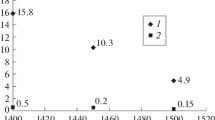Conclusions
The effects of admixtures of the oxides of iron, aluminum, titanium, silicon and phosphorus on sintering, strength factors, thermal shock resistance, deformation under load, linear expansion and microstructure of articles made from zirconia stabilized with calcium oxide, were studied.
According to their influence on the properties of the refractories, the impurities can be divided into three groups:
those which prevent stabilization;
those which have practically no effect on stabilization;
and those which help stabilization.
The first group includes P2O5, SiO2, Al2O3; the second group includes TiO2; and the third group includes Fe2O3.
Oxides preventing stabilization adversely affect deformation of the bodies under load, but increase the compressive strength. No general rale for the influence of these additions on the other properties of the products was evolved, which is probably connected with the different amounts and properties of the new phase which develops.
Titania reduces the compressive strength but does not influence the other properties of zirconia.
Oxides of iron, although they help stabilization of zirconia, lead to the formation of porous hearts in the products, which very adversely affects all properties of the products.
According to the reduction of the working properties of the articles of ZrO2 the admixtures investigated can be placed in the following order: phosphorus pentoxide, iron oxide, silica, titania and alumina.
Commercial zirconia for the production of high-grade refractories should contain the minimum amount of impurities, the presence of phosphorus pentoxide, iron oxide, and silica being particularly undesirable.
Similar content being viewed by others
Literature cited
W. Büssem, C. Schusterins, and A. Ungewis, Ber. Deutsch. Keram. Ges., 18, 433 (1937).
T. Yamanchi and S. Somiva, Trans. Brit. Cer. Soc., 2033 (1956).
É. K. Keler and A. B. Andreeva, Ogneupory, No. 2 (1957).
É. K. Keler and A. B. Andreeva, Ogneupory, No. 12 (1958).
É. K. Keler and A. B. Andreeva, Ogneupory, No. 6 (1961).
C. E. Curtis and H. G. Sowman, Journ. Amer. Cer. Soc., No. 6 (1953).
Journal of Abstracts “Chemistry,” 1961, No. 20, Abstract No. 20K, 162 [in Russian].
F. Howard, McMurdie, and F. P. Hall, Journ. Amer. Cer. Soc., No. 1 (1949).
Author information
Authors and Affiliations
Rights and permissions
About this article
Cite this article
Voronin, N.I., Gorodetskii, V.S. & Khavkina, E.I. The influence of impurities in the original materials on the properties of refractories made of zirconia. Refractories 4, 29–34 (1963). https://doi.org/10.1007/BF01283225
Issue Date:
DOI: https://doi.org/10.1007/BF01283225




